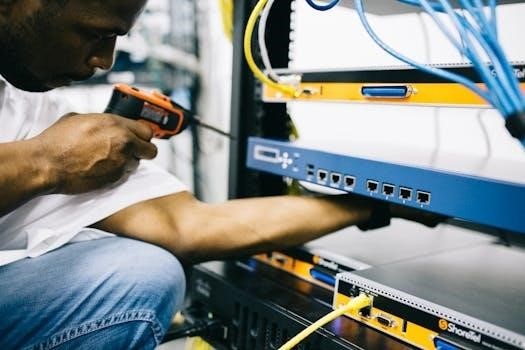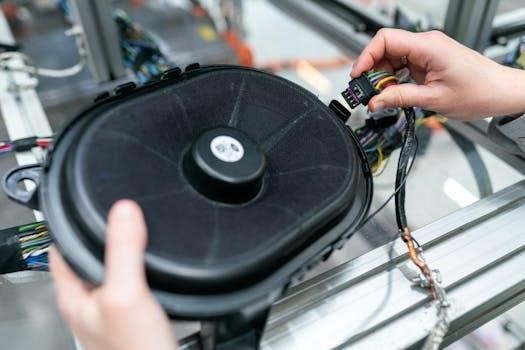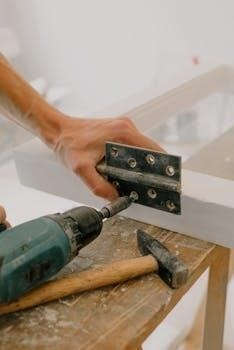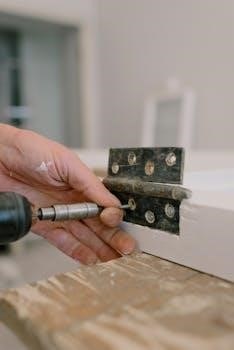Honeywell Pro 3000 Installation Overview
This section provides a general guide to the installation process of the Honeywell Pro 3000 series thermostat. It encompasses various key aspects, from wallplate mounting to initial setup procedures. Proper installation ensures reliable temperature control within your home or office.
Wallplate Installation
The initial step in installing your Honeywell Pro 3000 thermostat is properly mounting the wallplate. Begin by carefully separating the wallplate from the thermostat body. Locate the designated wire hole on the wallplate and gently pull the existing thermostat wires through it; Position the wallplate against the wall, ensuring it is level. Once correctly positioned, mark the screw hole locations using a pencil. Secure the wallplate to the wall using the provided screws and anchors, making sure it is firmly attached. This stable base is essential for the correct functioning of your thermostat. Before proceeding, double-check that the wallplate is level and securely mounted. This crucial step sets the foundation for a successful installation and accurate temperature readings from your new thermostat.
Power Options
The Honeywell Pro 3000 thermostat is designed to operate using a 20-30 Vac power supply, typically sourced from your heating and cooling system. It’s essential to ensure your system provides the correct voltage to avoid any operational issues. The thermostat’s running current for heating, cooling, and auxiliary heat ranges from 0.02 to 1.0 A, and is also designed to work with a powerpile system (750 mV DC running current 100 mA DC). For some installations, a common wire (C-wire) may be needed to provide a stable power source, this ensures consistent performance and prevents any battery drain. Always verify the power compatibility before installation to ensure a proper operation. It is essential to follow the manufacturer’s instructions to ensure a safe and reliable connection to the system.
Wiring Terminal Designations
Understanding the wiring terminal designations on the Honeywell Pro 3000 is crucial for proper installation. The terminals are labeled to correspond with your HVAC system’s wires. Common designations include “R” for power, “W” for heat, “Y” for cooling, and “G” for the fan. Some systems might also use “O” or “B” for reversing valve in heat pump systems, and “C” for the common wire. Carefully match the wires from your system to the correct terminals on the thermostat’s wallplate. This ensures that the thermostat can accurately control your heating and cooling functions. Refer to the thermostat’s installation manual to verify the specific terminal functionality for your model. Proper wiring is critical to prevent damage to the thermostat and the HVAC system.

Fan Operation Settings (TH3110D only)
This section details fan operation settings specifically for the TH3110D model. These settings allow you to configure how the fan operates in conjunction with your heating or cooling system.
Gas or Oil Fan Settings
For gas or oil heating systems, it’s crucial to leave the fan operation switch in the factory-set position. This default configuration is specifically designed for systems that have the control of the fan integrated within the heating call itself. Typically, in such systems, the furnace or boiler manages the fan’s operation in response to a demand for heat. The thermostat sends a signal for heat, and the system internally activates the fan. Therefore, there’s no need for the thermostat to directly control the fan. This setting ensures proper and efficient interaction between your thermostat and the specific needs of gas or oil heating equipment. Incorrect settings can lead to inefficient heating operation.
Electric or Heat Pump Fan Settings
When dealing with electric heat or heat pump systems, the fan switch setting needs an adjustment. Change the switch to the designated setting designed for these systems. This configuration allows the thermostat to take direct control over the fan when there’s a call for heat. In this setup, if a fan wire is connected to the ‘G’ terminal, the thermostat will actively manage the fan’s operation. This is different from gas or oil systems, where the heating system usually controls the fan. This ensures that with electric or heat pump systems, the fan is activated by the thermostat precisely when needed, optimizing the heating process and overall system efficiency. Proper setting is crucial for correct functionality.
Thermostat Mounting
This section details the process of physically attaching the thermostat to the wall. It involves securing the wallplate and then correctly positioning the thermostat unit onto this base, ensuring proper alignment.
Wallplate Attachment Procedure
Begin by carefully removing the existing thermostat from its base, if applicable, by gently pulling it from the bottom. Next, feed the wires through the designated wire hole in the new wallplate. Position the wallplate against the wall, ensuring it’s level, and use a pencil to mark the locations for screw holes. Using appropriate screws and anchors, securely fasten the wallplate to the wall. Double-check that it is firmly attached and level before proceeding. This ensures a stable foundation for the thermostat. After mounting, ensure wires are properly positioned for connection.

Installer Setup
This section details how to access and configure installer settings. It also covers the setup functions, options, and factory settings available. These steps are vital for proper system operation.
Accessing Installer Settings
To access the installer settings on your Honeywell Pro 3000 thermostat, you will need to follow a specific procedure. Begin by simultaneously pressing and holding the UP and DOWN buttons. Continue holding these buttons until the display on the thermostat changes. This action will grant you entry into the installer setup menu, where various configuration options are available. The thermostat display will then show the first setting that can be adjusted. This method allows for customization of the thermostat to match the installed heating/cooling system. Remember, specific settings are crucial for optimal performance, so proceed with caution and consult the manual for detailed instructions on each setting.
Setup Function Settings and Options
Within the installer setup menu, you’ll encounter various function settings and options that enable you to tailor the thermostat’s operation to your specific heating and cooling system. These settings include parameters for system type, fan control, and other features. The factory settings are typically in bold for easy identification. It is important to carefully review and adjust these settings to ensure proper thermostat functionality. For instance, settings related to gas, oil, electric, or heat pump systems can be configured. Incorrect settings may lead to improper heating or cooling operation. Always refer to the manual for a comprehensive explanation of each setting to avoid making mistakes.
System Test
After installation and setup, verify your system’s operation. Check both heating and cooling modes. Confirm the thermostat calls for and responds to temperature changes correctly to ensure proper function.
System Status Verification
To ensure your Honeywell Pro 3000 thermostat is functioning correctly after installation, a system status verification is crucial. Begin by setting the system switch to the “Heat” position and observe if the heating system activates as expected. Next, switch to the “Cool” position and check for the activation of the cooling system. Verify that the fan operates appropriately in both heating and cooling modes. If you have a heat pump system, confirm the auxiliary heat engages when needed. It’s also important to listen for any unusual noises or delays. Finally, ensure the thermostat responds correctly to temperature adjustments, making sure the display accurately reflects your settings and the current ambient temperature. If any irregularities are found, consult the troubleshooting section.

Troubleshooting
This section addresses common issues that may arise with the Honeywell Pro 3000 thermostat. It provides solutions for problems, ensuring smooth operation of your heating and cooling system.
Common Issues and Solutions
If your heating or cooling system isn’t responding, verify that the thermostat settings are within the acceptable range⁚ 40 to 90°F for heat and 50 to 99°F for cooling. Ensure all wiring connections are secure and match the designated terminals. If the display is blank, check the batteries and replace them if needed. For issues with temperature changes not registering, confirm that the thermostat is not in a temporary override mode. If the fan is not operating correctly, double-check the fan settings for gas/oil or electric/heat pump systems. If these steps don’t resolve the issues, it’s crucial to contact Honeywell Customer Care.

Specifications
This section details the electrical, environmental, and physical specifications of the Honeywell Pro 3000 series. These include voltage, current, temperature, humidity and dimensions for proper operation and installation.
Electrical and Environmental Details
The Honeywell Pro 3000 thermostat operates within a system voltage range of 20 to 30 Vac at 50/60Hz. It has a running current of 0.02 to 1.0 A for heat, auxiliary heat, emergency heat, and cooling. It is also suitable for powerpile systems with a 750 mV DC running current and 100 mA DC. The ambient operating temperature range is from 32 to 120 degrees Fahrenheit (0 to 48.9 degrees Celsius), and the storage temperature ranges from -20 to 120 degrees Fahrenheit (-28.9 to 48.9 degrees Celsius). The operating relative humidity range is between 5 and 90 percent, non-condensing. These specifications must be adhered to for proper functioning. The thermostat’s dimensions are approximately 3-13/16 inches in height, 5-3/8 inches in width and 1-1/4 inches in depth (97mm x 137mm x 32mm).
